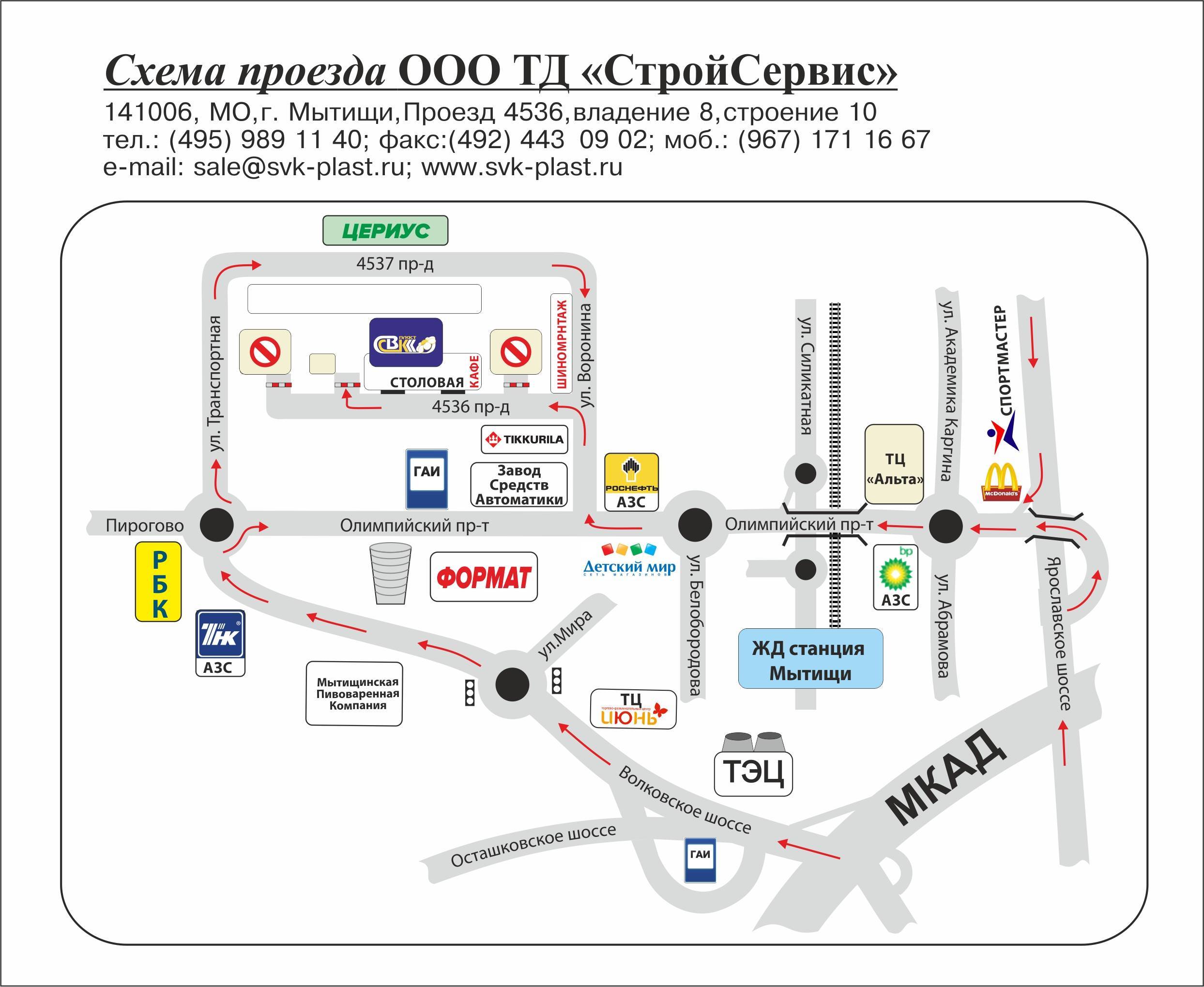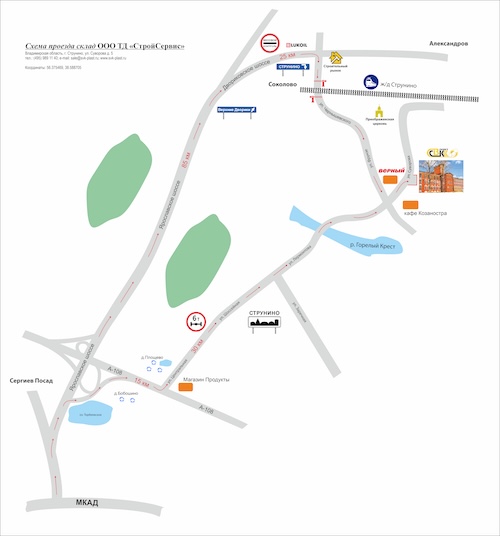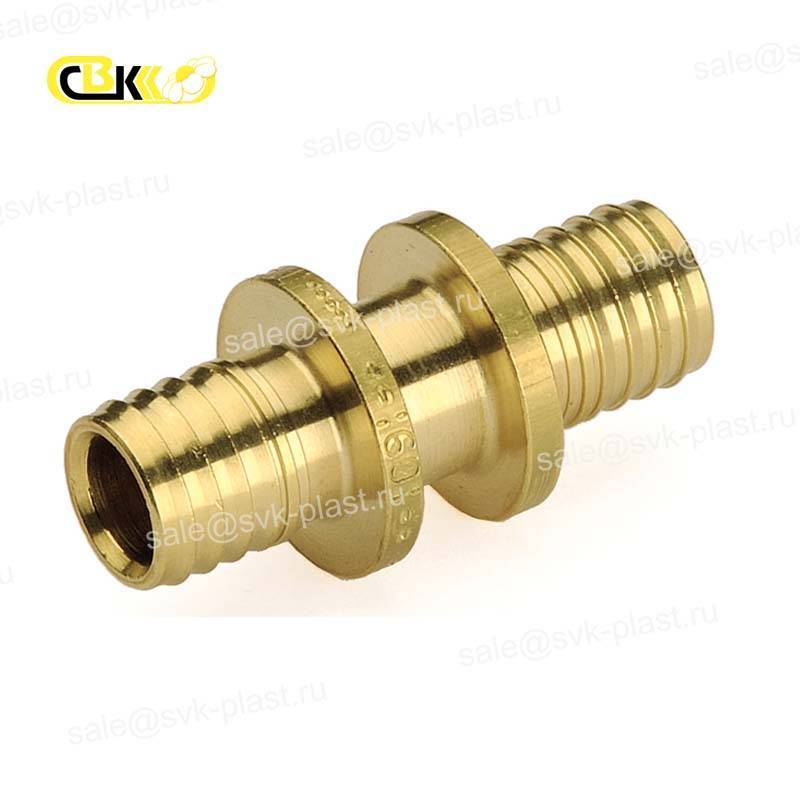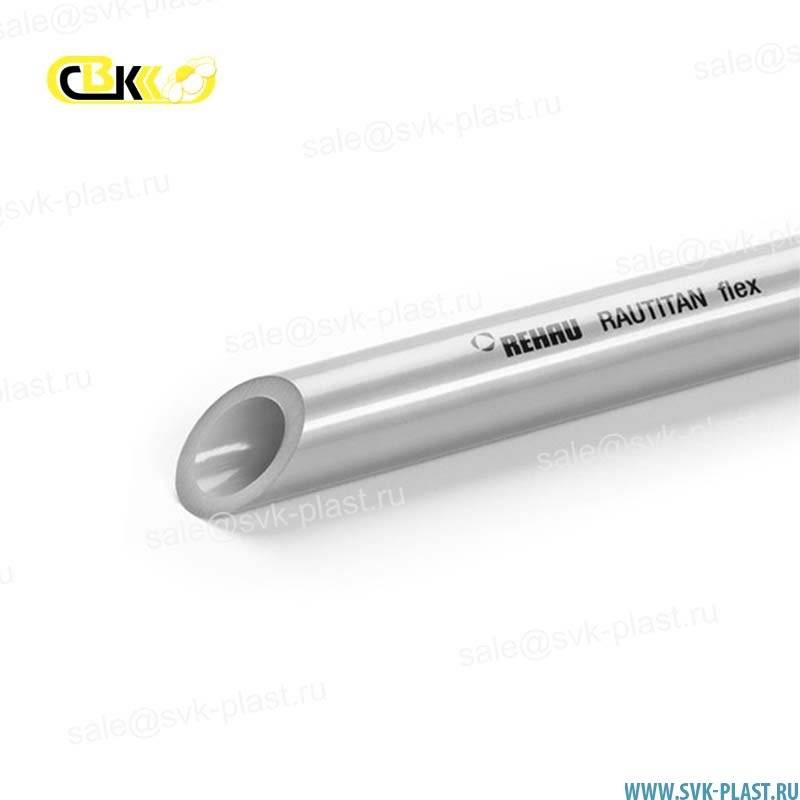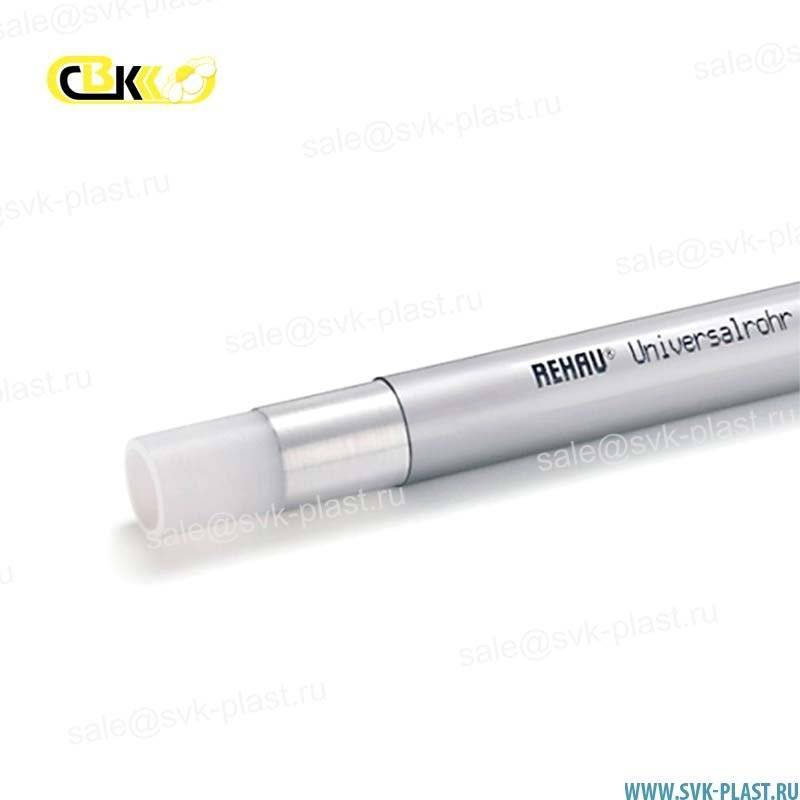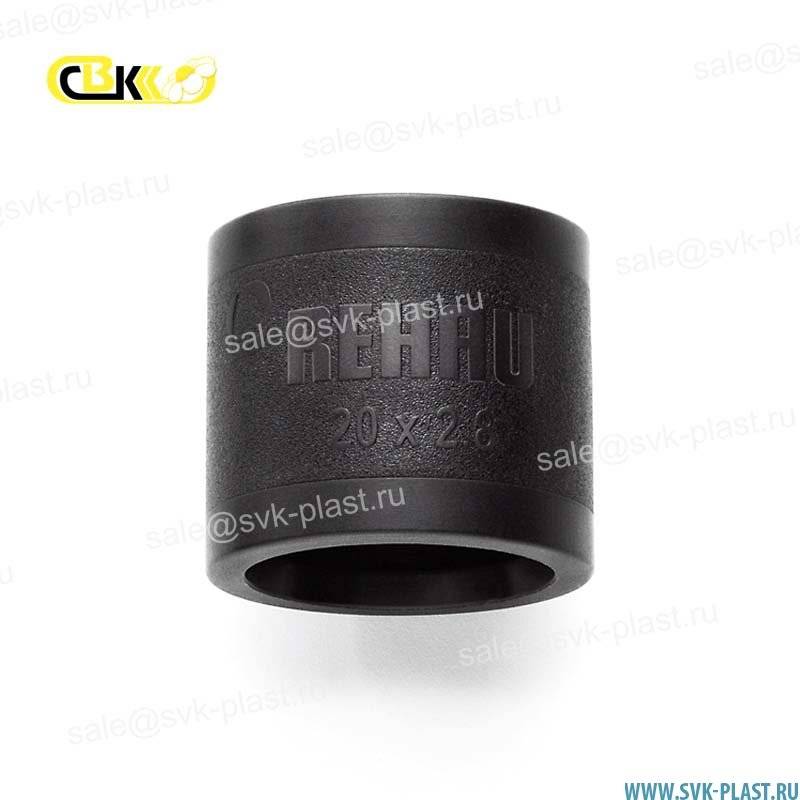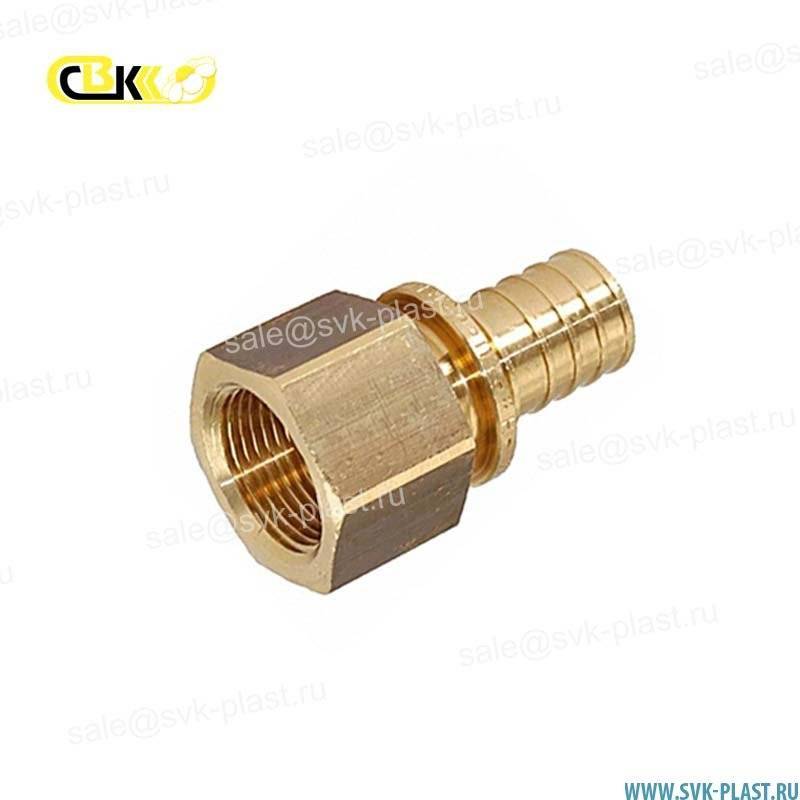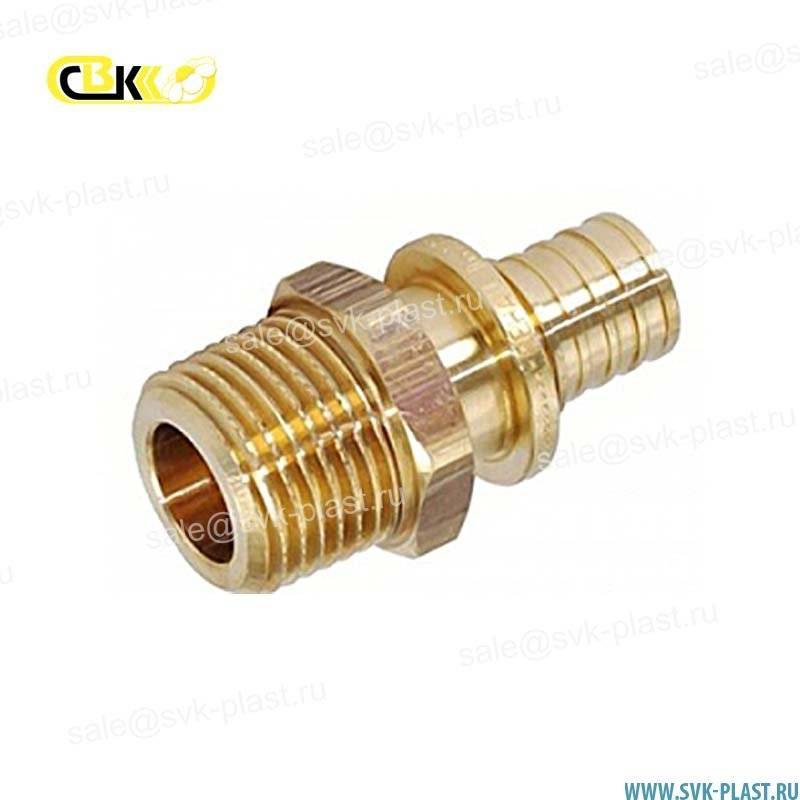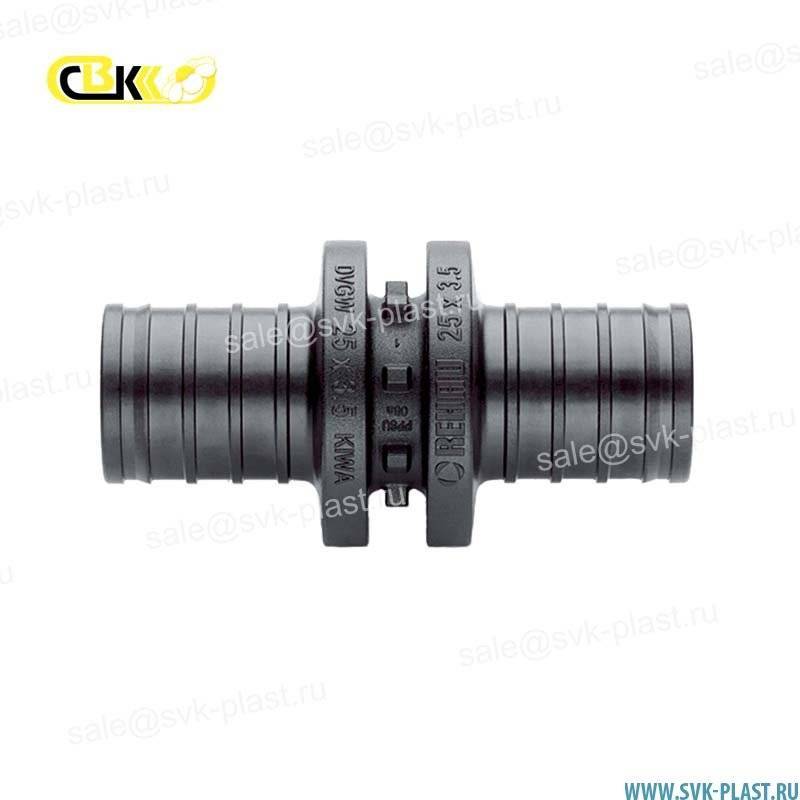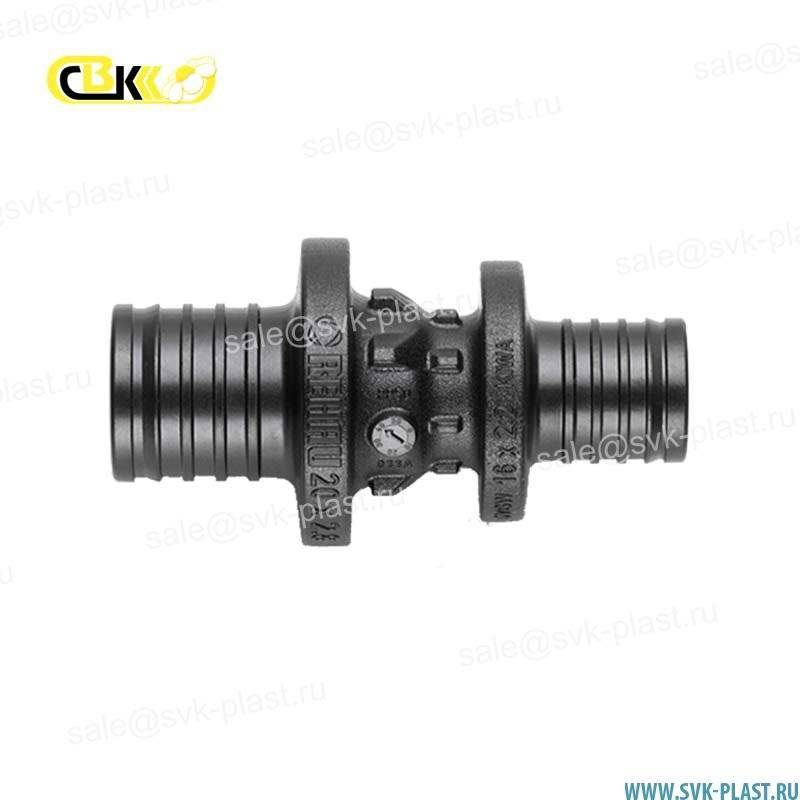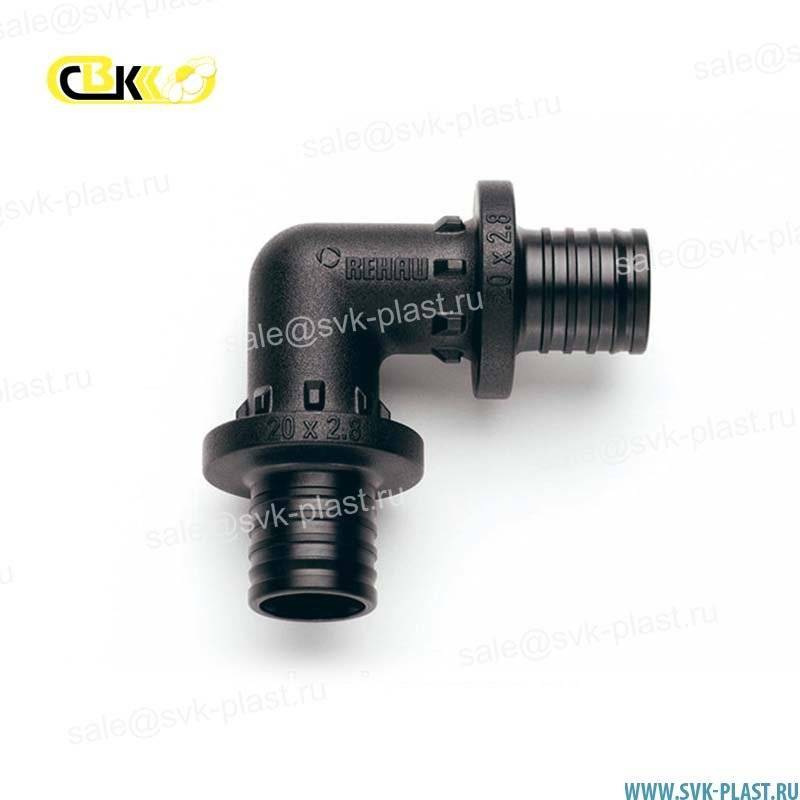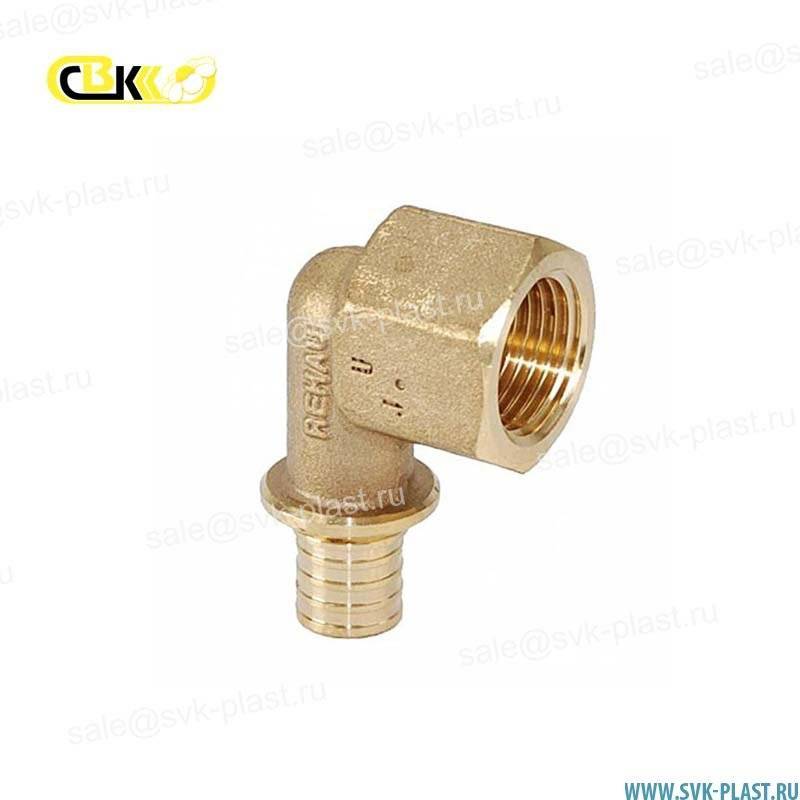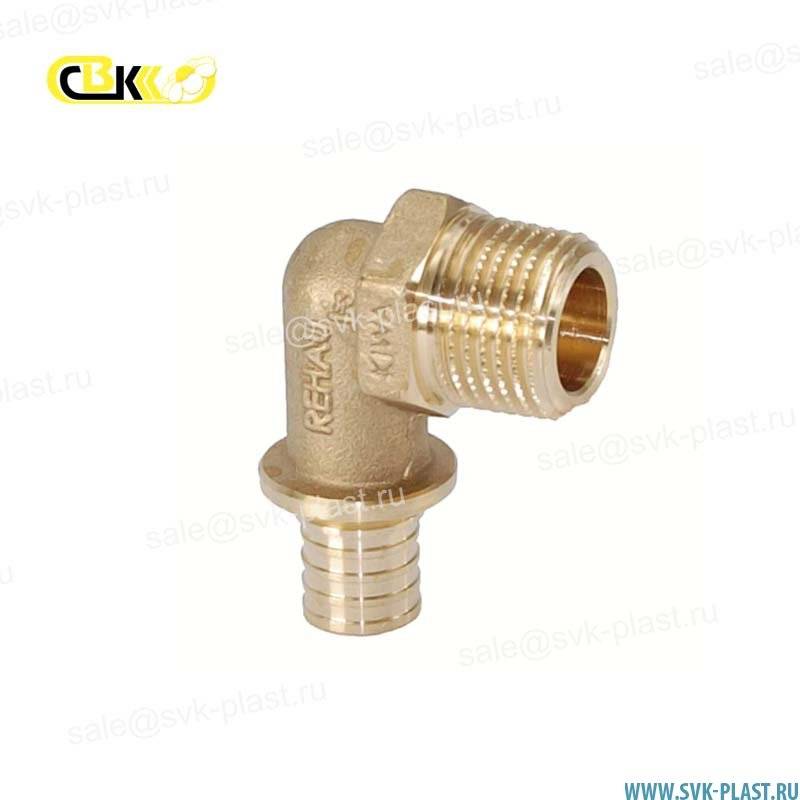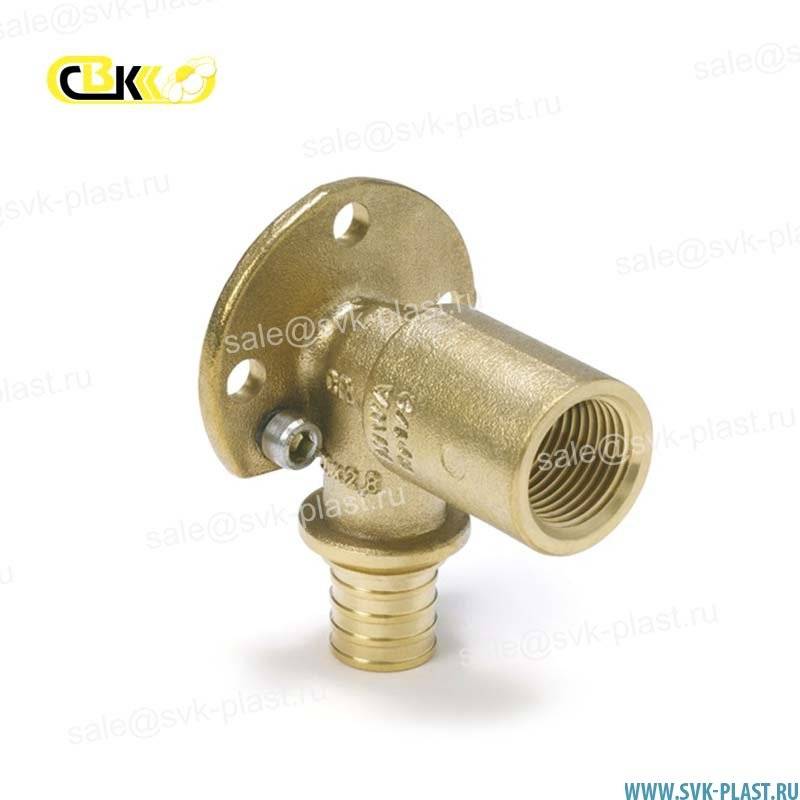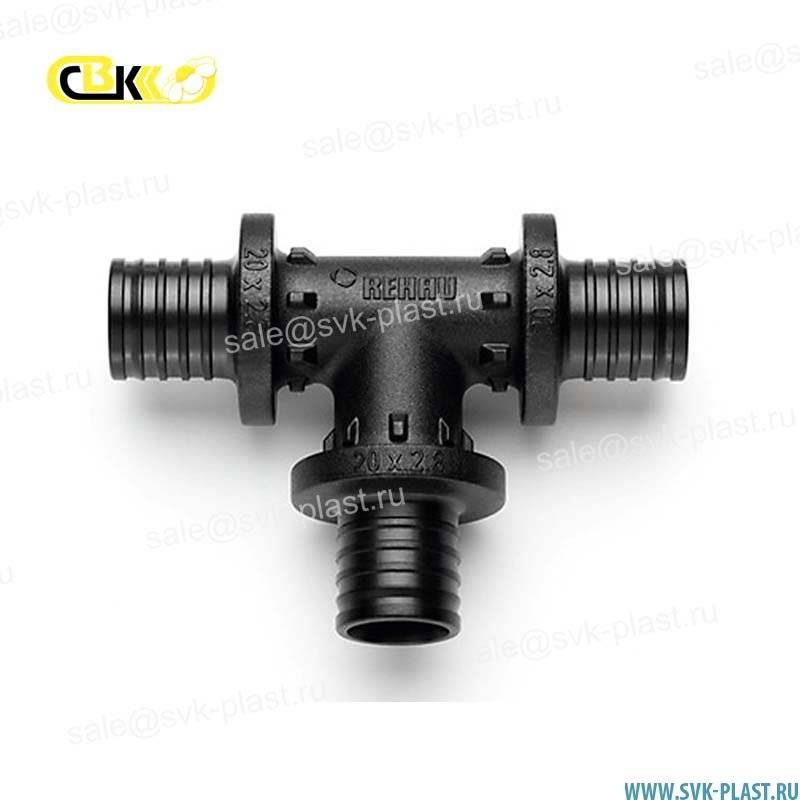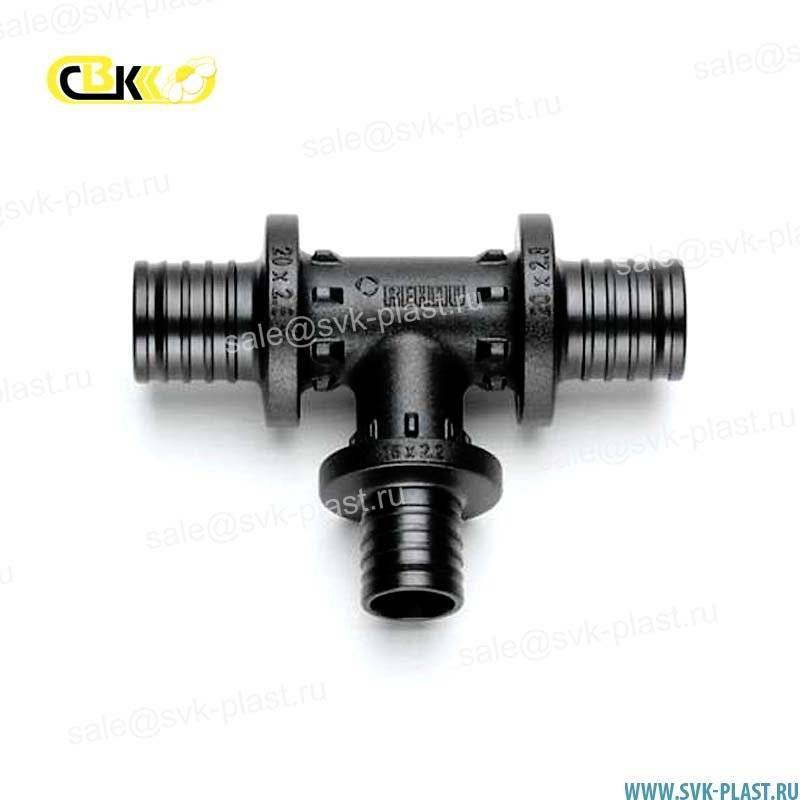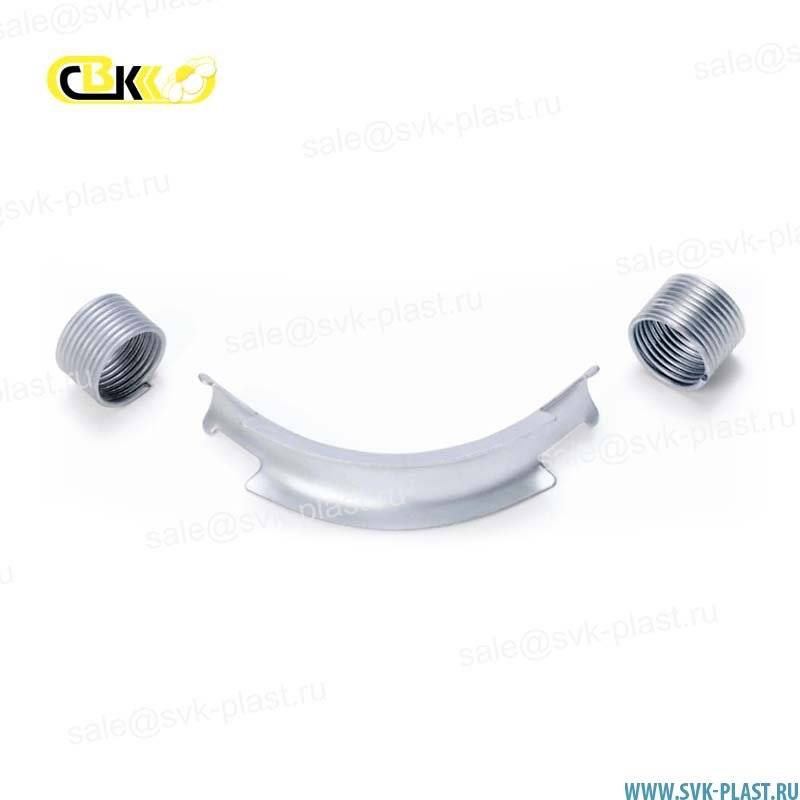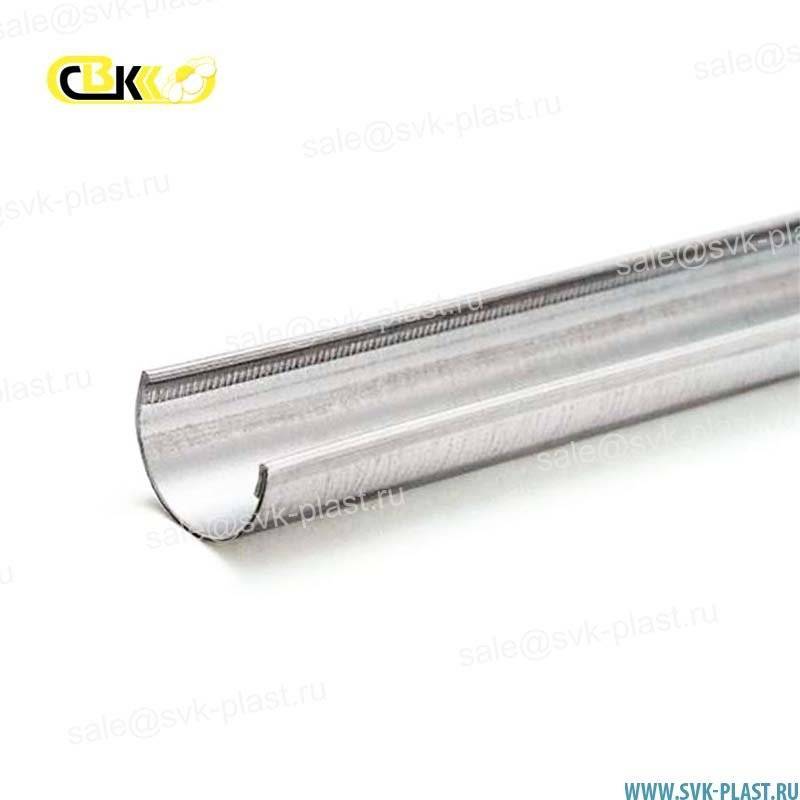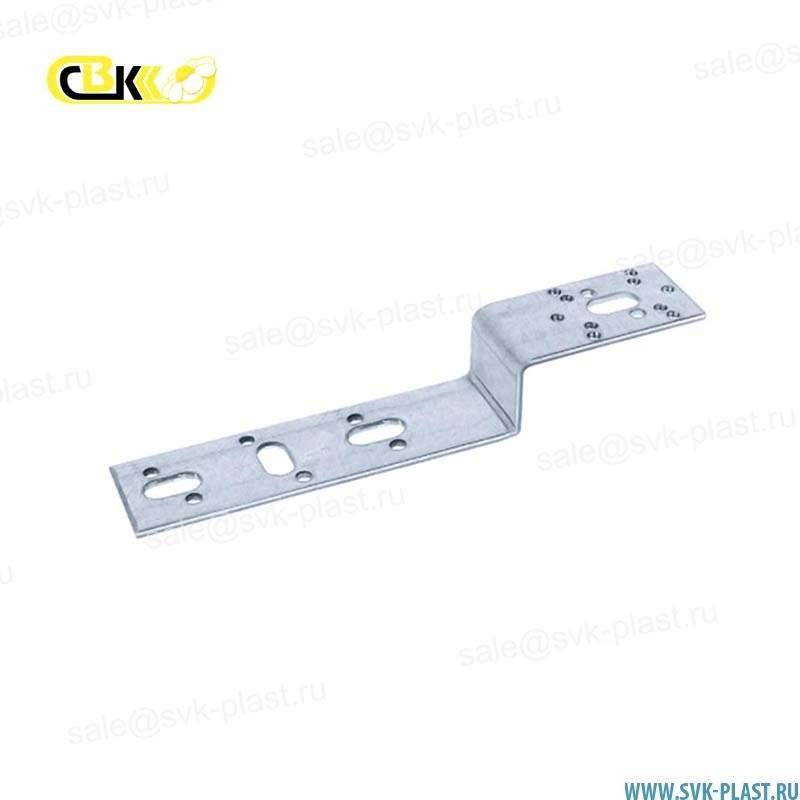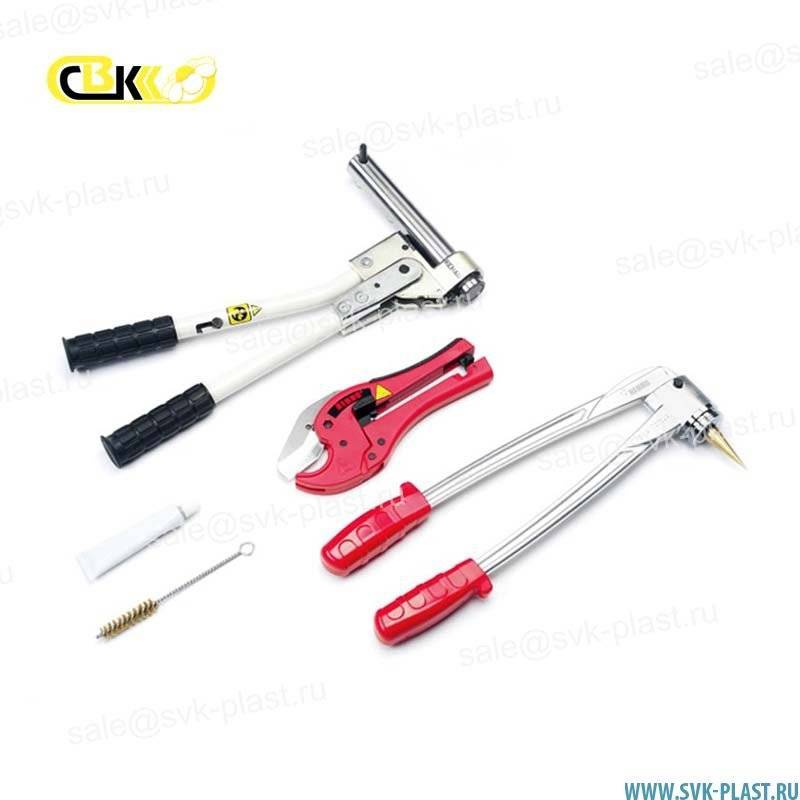PEX REHAU
REHAU is the founder of the production and market launch of cross-linked polyethylene pipelines. The company's history dates back to 1948, and the brand's country of origin is Germany.
REHAU pipeline systems are used for the construction of heating systems, water supply in multi-storey construction and heating systems, Underfloor heating and water supply in cottage construction. The Rehau range includes pipes with a diameter from 16 to 63 mm, to which The company offers a wide range of fittings and assemblies for installation.
Connection of fittings to pipelines is carried out by means of axial pressing. The fittings are made of either brass or polyphenylsulfone (PPSU) and are supplied with thick – walled sliding press sleeves made of the same material.Pipelines are made of cross-linked PE-xa polyethylene, peroxide cross-linking method.
PEX Coupling RAUTHERM S
| Vendor code | Name |
|---|---|
| 250277-002 | PEX Coupling connecting RAUTHERM S digital.brass 17 (2,0) |
| 258817-002 | PEX Coupling RAUTHERM S HP (Nickel) 17x1 / 2 |
| 246024-001 | PEX Coupling connecting RAUTHERM S digital.brass 14 (1,5) |
PEX Pipe (PE-Xa / EVAL)
| Vendor code | Name |
|---|---|
| 130400-050 | PEX Pipe Rautitan PE-Xa/Eval 32x4, 4 Flex |
| 130390-050 | PEX Pipe Rautitan PE-Xa/Eval 25x3, 5 Flex |
| 130380-100 | PEX Pipe Rautitan PE-Xa/Eval 20X2, 8 Flex |
| 136052-120 | PEX Pipe Rautitan PE-Xa/Eval 20X2, 8 Pink |
| 136042-120 | PEX Pipe Rautitan PE-Xa/Eval 16x2, 2 Pink |
| 136062-050 | PEX Pipe Rautitan PE-Xa/Eval 25x3, 5 Pink |
| 136072-050 | PEX Pipe Rautitan PE-Xa/Eval 32x4, 4 Pink |
PEX pipe Stabi (MP)
| Vendor code | Name |
|---|---|
| 130121-100 | PEX Pipe 16x2, 6 Stabil |
| 130131-100 | PEX Pipe 20X2, 9 Stabil |
| 130141-050 | PEX Pipe 25x3, 7 Stabil |
| 130101-005 | PEX Pipe 32x4, 7 Stabil |
PEX mounting sleeve
| Vendor code | Name |
|---|---|
| 160003-001 | PEX RAUTITAN px Sliding sleeve made of PVDF 25 |
| 160004-001 | PEX Sliding sleeve Rautitan PX from PVDF 32 |
| 160002-001 | PEX RAUTITAN px Sliding sleeve made of PVDF 20 |
| 160001-001 | PEX RAUTITAN px Sliding sleeve made of PVDF 16 |
| 246034-001 | PEX Sliding sleeve RAUTHERM S OC. brass 14 (1,5) |
| 250297-002 | PEX Sliding sleeve RAUTHERM S OC. brass 17 (2,0) |
PEX Coupling RAUTITAN MX BP
| Vendor code | Name |
|---|---|
| 139091-002 | PEX Coupling RAUTITAN MX BP 32x1 |
| 259525-002 | PEX Coupling RAUTITAN MX BP 20X1/2 |
| 259515-002 | PEX Coupling RAUTITAN MX BP 16x1/2 |
| 138253-001 | PEX Coupling RAUTITAN MX BP 20x3 / 4 |
| 259535-002 | PEX Coupling RAUTITAN MX BP 25x3 / 4 |
| 139101-002 | PEX Coupling RAUTITAN MX BP 32x 3/4 |
PEX Coupling RAUTITAN MX HP
| Vendor code | Name |
|---|---|
| 257336-002 | PEX Coupling RAUTITAN MX HP 25x1 |
| 259505-002 | PEX Coupling RAUTITAN MX HP 25x3 / 4 |
| 137955-001 | PEX Coupling RAUTITAN MX HP 16x1/2 |
| 137985-001 | PEX Coupling RAUTITAN MX HP 20x3 / 4 |
| 139051-002 | PEX Coupling RAUTITAN MX HP 32x1 |
| 137975-001 | PEX Coupling RAUTITAN MX HP 20X1/2 |
| 137965-001 | PEX Coupling RAUTITAN MX HP 16X3 / 4 |
| 139181-002 | PEX Coupling RAUTITAN MX HP 25x1/2 |
| 139081-002 | PEX Coupling RAUTITAN MX HP 32x 3/4 |
Clutch connecting PEX (PPSU)
| Vendor code | Name |
|---|---|
| 160014-001 | PEX Coupling RAUTITAN PX (PPSU) 32 |
| 160013-001 | PEX Coupling RAUTITAN PX (PPSU) 25 |
| 160012-001 | PEX Coupling RAUTITAN PX (PPSU) 20 |
| 160011-001 | PEX Coupling RAUTITAN PX (PPSU) 16 |
PEX Coupling connecting RAUTITAN PX, transition
| Vendor code | Name |
|---|---|
| 160044-001 | PEX Coupling connecting RAUTITAN PX, Rex. 32x25 |
| 160043-001 | PEX Coupling connecting RAUTITAN PX, TRANS. 25x20 |
| 160041-001 | PEX Coupling connecting RAUTITAN PX, TRANS. 20x16 |
| 160042-001 | PEX Coupling connecting RAUTITAN PX, TRANS. 25x16 |
Elbow RAUTITAN PEX (PPSU)
| Vendor code | Name |
|---|---|
| 160023-001 | Elbow RAUTITAN PEX (PPSU) 90 gr. 25 |
| 160022-001 | Elbow RAUTITAN PEX (PPSU) 90 gr. 20 |
| 160054-001 | Elbow RAUTITAN PEX (PPSU) 45 gr. 32 |
| 160021-001 | Elbow RAUTITAN PEX (PPSU) 90 gr. 16 |
| 160024-001 | Elbow RAUTITAN PEX (PPSU) 90 gr. 32 |
| 160052-001 | Elbow RAUTITAN PEX (PPSU) 45 gr. 20 |
| 160053-001 | Elbow RAUTITAN PEX (PPSU) 45 gr. 25 |
PEX Square RAUTITAN MX BP
| Vendor code | Name |
|---|---|
| 137295-001 | PEX Square RAUTITAN MX BP 16x1/2 |
| 137124-001 | PEX Square RAUTITAN MX BP 16X3 / 4 |
| 137305-001 | PEX Square RAUTITAN MX BP 20X1/2 |
| 137134-001 | PEX Square RAUTITAN MX BP 20x3 / 4 |
| 241255-001 | PEX Square RAUTITAN MX BP 25x1 |
PEX Square RAUTITAN MX HP
| Vendor code | Name |
|---|---|
| 139491-002 | PEX Square RAUTITAN MX HP 16x1/2 |
| 137545-001 | PEX Square RAUTITAN MX HP 20x3 / 4 |
| 139511-001 | PEX Square RAUTITAN MX HP 25x3 / 4 |
| 137433-001 | PEX Square RAUTITAN MX HP 32x1 |
| 139501-002 | PEX Square RAUTITAN MX HP 20X1 / 2 |
PEX RAUTITAN Square with MX VR mount
| Vendor code | Name |
|---|---|
| 138591-405 | PEX Square RAUTITAN with mounting MX BP 25 x 3/4 |
| 138451-405 | PEX Square RAUTITAN with mounting MX BP 20 x 1/2 extended |
| 138441-405 | PEX Square RAUTITAN with mounting MX BP 16 x 1/2 extended |
| 138461-405 | PEX Square RAUTITAN with mounting MX BP 16 x 1/2 |
| 138471-405 | PEX Square RAUTITAN with mounting MX BP 20 x 1/2 |
| 139191-405 | PEX Square RAUTITAN with mounting MX BP 20 x 3/4 |
PEX Tee
| Vendor code | Name |
|---|---|
| 160033-001 | RAUTITAN PEX Tee (PPSU) PX 25 |
| 160032-001 | PEX Tee RAUTITAN (PPSU) PX 20 |
| 366021-001 | PEX Tee RAUTITAN RX BP 32x3 / 4 |
| 160031-001 | RAUTITAN PEX Tee (PPSU) PX 16 |
| 160034-001 | RAUTITAN PEX Tee (PPSU) PX 32 |
| 366020-001 | PEX Tee RAUTITAN RX BP 25x3 / 4 |
PEX Tee transition
| Vendor code | Name |
|---|---|
| 160091-001 | PEX Tee RAUTITAN PX go to. 32х25х25 |
| 160082-001 | PEX Tee RAUTITAN PX go to. 25x16x16 |
| 160087-001 | PEX Tee RAUTITAN PX go to. 32х20х25 |
| 160085-001 | PEX Tee RAUTITAN PX go to. 25x20x20 |
| 160081-001 | PEX Tee RAUTITAN PX go to. 20x16x16 |
| 160064-001 | PEX Tee RAUTITAN PX go to. 32х16х32 |
| 160083-001 | PEX Tee RAUTITAN PX go to. 25x16x20 |
| 160071-001 | PEX Tee RAUTITAN PX go to. 20x20x16 |
| 160102-001 | PEX Tee RAUTITAN PX go to. 16x25x16 |
| 160103-001 | PEX Tee RAUTITAN PX go to. 20x25x16 |
| 160075-001 | PEX Tee RAUTITAN PX go to. 32х32х25 |
| 160084-001 | PEX Tee RAUTITAN PX go to. 25x20x16 |
| 160074-001 | PEX Tee RAUTITAN PX go to. 32х32х20 |
| 160063-001 | PEX Tee RAUTITAN PX go to. 25x20x25 |
| 160065-001 | PEX Tee RAUTITAN PX Rex. 32x20x32 |
| 160104-001 | PEX Tee RAUTITAN PX go to. 20x25x20 |
| 160061-001 | PEX Tee RAUTITAN PX go to. 20x16x20 |
| 160062-001 | PEX Tee RAUTITAN PX go to. 25x16x25 |
| 160072-001 | PEX Tee RAUTITAN PX go to. 25x25x16 |
| 160066-001 | PEX Tee RAUTITAN PX Rex. 32x25x32 |
| 160073-001 | PEX Tee RAUTITAN PX go to. 25x25x20 |
PEX turn Lock 90 gr with rings
| Vendor code | Name |
|---|---|
| 138881 | PEX turn Lock 90 gr. with 16 rings |
| 138891 | PEX turn Lock 90 gr. with 20 rings |
| 138351 | PEX turn Lock 90 gr. with 25 rings |
| 138641 | PEX turn Lock 90 gr. with 32 rings |
PEX Fixing chute
| Vendor code | Name |
|---|---|
| 138063-001 | PEX Fixing chute 32 (3M) |
| 138053-001 | PEX Fixing chute 25 (3M) |
| 138033-001 | PEX Fixing chute 16 / 17 (3M) |
| 138043-001 | PEX Fixing chute 20 (3M) |
Brackets
| Vendor code | Name |
|---|---|
| 137115-405 | PEX relief Plank for seaweed type O 75/150 long |
| 241465-405 | PEX relief Plank for seaweed type O 75/150 short |
| 137075-405 | PEX Plank for water grid Z 213x40x30 |
Tool
| Vendor code | Name |
|---|---|
| 137364-001 | PEX Set of pressing vises 25 / 32mm |
| 137764-005 | PEX machine tool Kit Rautool M1 |
| 137744-001 | PEX Set of 16/20mm compression vise |
| 139622-001 | PEX expansion Nozzle 25x3. 5 (PE-X) |
| 139612-001 | PEX expansion Nozzle 20X2. 8 (PE-X) |
| 139632-001 | PEX expansion Nozzle 32x4. 4 (PE-X) |
| 209393-001 | PEX expansion Nozzle 40x5. 5 (PE-X) |
| 240931-001 | PEX Tube L-shaped RAUTITAN to the radiator 16x15x500 |
| 208891-001 | PEX Expander battery hydraulic RAUTOOL Xpand |
| 139602-001 | PEX expansion Nozzle 16x2. 2 (PE-X) |
| 244601-001 | PEX expansion Nozzle 32x4. 7 (STABIL) |
| 244591-00 | PEX expansion Nozzle 25x3. 7 (STABIL) |
| 244571-001 | PEX expansion Nozzle 16. 2x2. 6 (STABLE) |
| 244581-001 | PEX expansion Nozzle 20X2, 9 (STABIL) |
| 209392-001 | PEX expansion Nozzle 40x3, 7 (PE-X) |
| 203595-001 | PEX machine tool Kit Rautool A3 |
Application of cross-linked polyethylene in heating systems
Heating systems have strict requirements for the quality and wear resistance of the materials used, in particular, they must be designed to work under high pressure and regular fluctuations in the temperature of the coolant. Polyethylene pipes meet all the above requirements.
Crosslinking of polyethylene with electronic flow makes this material flexible, strong and resistant to aggressive media. Manufacturers use several methods for making cross-linked polyethylene. Different technologies provide different operating parameters of the finished material, however, the pros and cons are always the same.
ADVANTAGES OF CROSS-LINKED POLYETHYLENE
This type of material, unlike ordinary polyethylene, is not prone to softening and deformation at high temperatures. Due to this quality, it is used in heating systems and in the arrangement of Underfloor heating. Cross-linked polyethylene (PEX) also has other advantages:
- does not rust;
- does not crack;
- durable;
- internal surfaces are not covered with lime and silt;
- provides excellent sound insulation;
- absolutely safe for people and animals;
- the pipes are easy to install and do not cause problems during transportation;
- ease;
- maintaining strength characteristics even at temperatures below 0СC;
- resistance to severe pressure surges and temperature fluctuations;
- the presence of molecular memory;
- cheapness;
- ecological safety;
- it has a long service life (about 50 years).
Due to the above advantages, this material is used everywhere, but it has several serious disadvantages:
- not resistant to UV light;
- not resistant to surfactants;
- it is not resistant to mechanical damage, in particular, caused by rodents;
- it is destroyed under the influence of oxygen.
To reduce the negative impact of solar radiation, a special protective lacquer coating is applied to the polyethylene pipes.
If oxygen gets to the inner layers of the pipes, the destruction of the material will be quite rapid. Therefore, many manufacturers apply an additional protective layer, also known as an oxygen barrier, to the polyethylene. This coating reduces the likelihood of pipeline failure, but increases its cost.
DEVICE OF PEX PIPES AND THEIR MANUFACTURING METHODS
Polyethylene pipes have 5 key layers, including:
- Inner polyethylene layer;
- Adhesive layer;
- Oxygen barrier;
- Adhesive layer;
- Outer polyethylene layer.
Such a five-layer structure guarantees increased heat resistance of pipes and no deformation at the temperature of the coolant up to 95⁰C . All this makes PEX the best option for the heating system.
For the production of pipes, the extrusion method is used, in which the molten polyethylene is given the desired shape, and then the product is subjected to vacuum calibration. Delivery of finished pipes is carried out in bays or sections, based on the size of their cross-section.
TECHNICAL PARAMETERS OF PIPES
The unique qualities of this material allowed them to replace many solid substances. Let's list the key characteristics of cross-linked polyethylene:
- The melting point is 200⁰c;
- The Gorenje temperature is approximately 400⁰C;
- The tensile strength is in the range of 350-800%;
- The density is 940 kg / m3.
Manufacturers produce a huge range of polyethylene pipes of different cross-sections. Today on the market you can find products with a diameter from 1.2 to 25 cm, however, buyers most often buy pipes with a cross-section in the range of 1.6-2.5 cm.
To date, more than 15 methods of crosslinking polyethylene have been developed, but only 3 of them are most popular. These include stitching:
- Peroxide (REX-a);
- Silane (PEX-b);
- Radiation method (PEX-c).
The highest cost, and at the same time the highest quality, is distinguished by the method of crosslinking with peroxide. It is able to bind approximately 85% of the molecules, resulting in a strong material that is resistant to high temperatures.
PEX-a is the optimal way to manufacture cross-linked polyethylene, and all other technologies are aimed at reducing the cost of the production process with a loss of material quality.
REINFORCED PIPES FOR HEATING SYSTEMS
This material appeared on the market relatively recently and is even more durable and heat-resistant than ordinary PEX. To get it, special nylon threads and other components are added to the walls of pipes during their extrusion.
There are the following methods of pipe reinforcement:
- nylon thread;
- the foil is made from aluminium;
- kevlar.
Reinforcement allows you to increase the level of permissible pressure in the system to 30 ATM, and the pipes themselves become resistant to cracks during torsion or bending. However, such products are more expensive, because their manufacture requires special equipment.
MAIN MANUFACTURERS
Cross-linked polyethylene pipes are the best choice for a modern heating system. Currently, polyethylene pipes are produced by many foreign and Russian manufacturers. Let's list the most popular brands:
- German Rehau;
- Italian Valtec;
- Swedish Uponor;
- German TESE;
- Russian Perpex;
- Spanish STOUT.
Rehau is an internationally recognized leader in this field. The brand's products are of the highest quality and excellent performance. The cost of products from this manufacturer is quite high, so buyers often choose a more economical option, for example, pipes of the STOUT brand.
STOUT company produces professional sanitary equipment designed for heating and water supply systems. Its products are manufactured at the same factory facilities in Europe as the products of expensive brands in the premium segment.
The warranty period for most STOUT products is 5 years. All components are perfectly matched to each other, they are quickly installed, do not create problems in maintenance and are adapted to work in Russian conditions.
Different manufacturers use different methods of crosslinking polyethylene: REX-a, REX-b or REX-C. The best method of crosslinking today is peroxide (REX-a), so we recommend paying attention to the products of manufacturers STOUT, Uponor and Rehau, produced using this technology.
SPECIFICS OF INSTALLATION WORK
In the case of polyethylene pipes, installation work is performed using one of the 2 types of fittings:
- compressive;
- pressure plates.
Installation using compression fittings is considered the simplest method of installation. Its main advantage is the ability to repeatedly assemble and disassemble the system at the joints if necessary. When installing Underfloor heating according to this method, you need to consistently perform a number of actions:
- Stringing the crimp nut on the pipe.
- Stringing the split ring on the pipe.
- Fitting the pipeline to the fitting.
- Tightening connections using a spanner.
In a situation where pressure fittings are used, an all-in-one connection is obtained during installation. We recommend that you pre-prepare the mounting press and follow the following sequence of actions:
- Stringing the clamping sleeve on the pipe.
- Insert an expander of a suitable cross-section into the pipeline.
- Inserting the pipeline into the fitting.
- The press fit of the sleeve.
After completing the work, wait a few seconds to ensure that the resulting connection is strong and reliable. Please note that removing the pipe from the fitting will not be possible in the future due to the molecular memory of cross-linked polyethylene.


